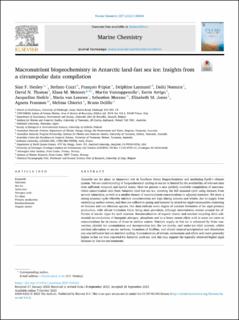| dc.description.abstract | Antarctic sea ice plays an important role in Southern Ocean biogeochemistry and mediating Earth's climate system. Yet our understanding of biogeochemical cycling in sea ice is limited by the availability of relevant data over sufficient temporal and spatial scales. Here we present a new publicly available compilation of macronutrient concentration data from Antarctic land-fast sea ice, covering the full seasonal cycle using datasets from around Antarctica, as well as a smaller dataset of macronutrient concentrations in adjacent seawater. We show a strong seasonal cycle whereby nutrient concentrations are high during autumn and winter, due to supply from underlying surface waters, and then are utilised in spring and summer by mixed ice algal communities consisting of diatoms and non-siliceous species. Our data indicate some degree of nutrient limitation of ice algal primary production, with silicon limitation likely being most prevalent, although uncertainties remain around the affinities of sea-ice algae for each nutrient. Remineralisation of organic matter and nutrient recycling drive substantial accumulations of inorganic nitrogen, phosphate and to a lesser extent silicic acid in some ice cores to concentrations far in excess of those in surface waters. Nutrient supply to fast ice is enhanced by brine convection, platelet ice accumulation and incorporation into the ice matrix, and under-ice tidal currents, whilst nutrient adsorption to sea-ice surfaces, formation of biofilms, and abiotic mineral precipitation and dissolution can also influence fast-ice nutrient cycling. Concentrations of nitrate, ammonium and silicic acid were generally higher in fast ice than reported for Antarctic pack ice, and this may support the typically observed higher algal biomass in fast-ice environments. | |
